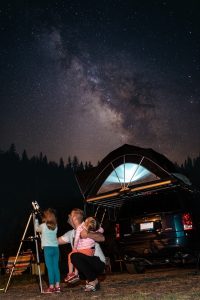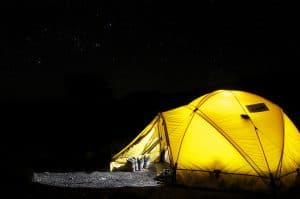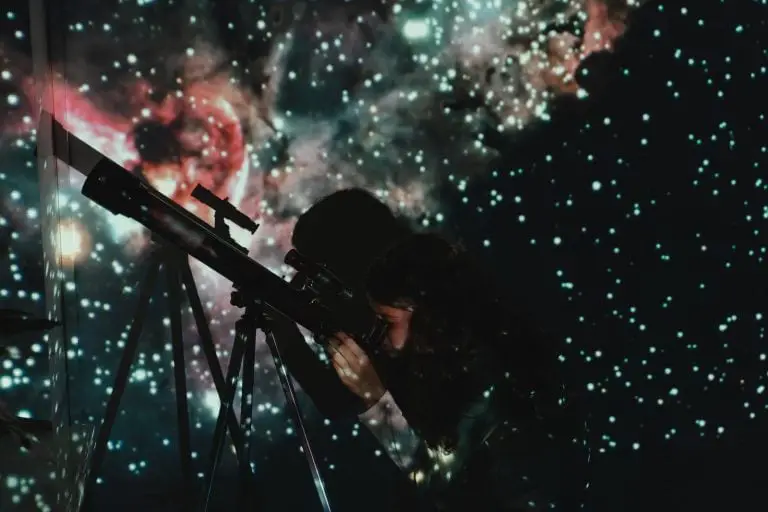In today’s fast-paced digital age, it’s becoming increasingly important to introduce our children to the wonders of the natural world, and what better way to do so than by gazing at the night sky? Backyard astronomy with kids is a fantastic way to spark their curiosity, encourage a love for science, and create lasting memories. In this comprehensive guide, we’ll take you on a journey through the cosmos, from identifying the brightest stars to observing meteor showers and even the International Space Station. Get ready for an adventure that’s out of this world!
Getting Started with Backyard Astronomy

Selecting the Right Equipment
Choosing the right equipment is crucial for a successful stargazing experience with kids. If your children are new to astronomy, start with binoculars or just the naked eye. Binoculars provide a wider field of view, making it easier to spot constellations and bright stars. For older kids and those with a growing interest, a beginner’s telescope could be a great investment. Be sure to research and choose a telescope suitable for beginners.
It’s also essential to consider factors like portability and ease of use when selecting equipment for kids. Telescopes can be complex, so opt for models with straightforward setups. And remember, even without equipment, the night sky offers plenty of wonders visible to the naked eye.
Creating a Stargazing Haven
Designing a dedicated stargazing area in your backyard enhances the experience and makes it more comfortable for your young astronomers. Lay out a blanket or set up some chairs, ensuring everyone has a clear view of the night sky. To combat light pollution, which can hinder stargazing, consider installing outdoor-friendly light fixtures that can be dimmed or shielded. A dark sky is your canvas for exploring the cosmos.
To take your stargazing area to the next level, consider adding a telescope pier or mount. This provides stability for telescopes and binoculars and prevents unwanted vibrations when observing celestial objects.
Learning the Basics of Astronomy

Constellations and Stars
Introducing your kids to constellations and stars can be an awe-inspiring experience. Start with well-known constellations like the Big Dipper, which is part of Ursa Major, and the North Star (Polaris), a reliable guide in the northern hemisphere. Use an actual map of the night sky or astronomy apps to help you identify these celestial landmarks. Encourage your kids to trace the shapes of constellations with their fingers, making stargazing interactive and educational.
As you explore the night sky, teach your children about the concept of stars as distant suns and how they come in various sizes, colors, and brightness levels. The sky is an ever-changing canvas, and knowing the basic constellations and stars is like learning the alphabet of the universe.
Exploring the Moon
The moon is a celestial neighbor that often graces the night sky. Its changing phases, from crescent to full moon, offer a fascinating lunar cycle to observe. Consider making a game out of identifying the moon’s phases, and challenge your kids to predict its appearance on different nights.
For a more detailed view, a telescope or high-quality lens can reveal the moon’s surface features, including craters, mountains, and plains. Taking a lunar selfie through a telescope can be a memorable activity, capturing your kids’ fascination with the cosmos.
Planets in the Night Sky
Our solar system is home to several planets, some of which are visible in the clear night sky. Venus, often referred to as the “evening star” when it’s visible after sunset or the “morning star” when it’s seen before sunrise, is one of the brightest objects in the sky. Point out Venus to your kids, and explain that it’s a planet similar to Earth but with a different atmosphere.
Engage your children in discussions about the other planets in our solar system, such as Jupiter and Saturn. While these planets may not always be visible, it’s exciting to know they’re up there among the stars.
Engaging Activities for Stargazing with Kids

Meteor Showers and Shooting Stars
Meteor showers are celestial events that captivate stargazers of all ages. These displays occur when the Earth passes through the debris trail left by a comet, resulting in a flurry of shooting stars across the night sky. To make meteor shower nights special, bring blankets, snacks, and warm drinks, and lie down under the stars. Encourage your kids to make wishes upon shooting stars – it’s a tradition that adds a touch of magic to the experience.
Before each meteor shower, check a reliable astronomy calendar to find the best times for viewing. Some meteor showers occur annually, so you can schedule stargazing nights in advance.
Stargazing Projects with Kids
Enhance your children’s engagement with the cosmos by involving them in astronomy-themed projects. Creating a model of the solar system using craft materials is not only educational but also fun. You can also design a star chart together, helping your kids understand the positions of constellations and stars at different times of the year.
A laser pointer can be a valuable tool for stargazing with kids. Use it to trace constellations in the night sky, making learning about the stars a hands-on experience. These projects ignite creativity and curiosity, turning stargazing into a rewarding family activity.
Exploring the Night Sky

Identifying Star Clusters and the Milky Way
As your kids gain experience in stargazing, you can introduce them to more challenging celestial objects like star clusters and the Milky Way. Star clusters are groups of stars that are gravitationally bound together. They come in two main types: open clusters and globular clusters. Open clusters, such as the Pleiades, are often characterized by a loose arrangement of stars and are relatively easy to spot. Globular clusters, like Messier 13, are denser collections of stars that appear as compact, spherical patches of light.
The Milky Way, our home galaxy, is a stunning band of stars, gas, and dust that spans across the night sky. It’s best observed on clear, dark nights away from city lights. When you and your kids venture out to explore the Milky Way, consider using binoculars or a telescope to get a closer look at its intricate structure.
To locate star clusters and the Milky Way, use stargazing apps or sky maps to identify their positions in the night sky. Encourage your children to connect the dots between the constellations and these celestial wonders, deepening their understanding of the vastness of the universe.
Spotting Satellites and Other Bright Objects
The night sky is not only populated by stars and planets but also by artificial satellites, including the International Space Station (ISS). These bright objects move steadily across the sky and are a thrilling sight for young astronomers. To increase your chances of spotting satellites and the ISS, use dedicated apps or websites that provide real-time tracking information. These tools will help you plan your stargazing nights and predict when these bright objects will pass overhead.
Watching satellites glide across the sky can be a great way to engage kids in discussions about space exploration and the significance of human-made objects in Earth’s orbit. You can even challenge your children to identify different satellites and learn about their missions.
Remember that satellite passes are relatively short, so be prepared to observe them at the right time and location. As you and your kids become more skilled at satellite spotting, you may even catch glimpses of other celestial phenomena, such as iridium flares (sudden, brief flashes of light from the sun’s reflection off satellite surfaces) or the Hubble Space Telescope.
Safety and Best Practices
Protecting Young Astronomers
When it comes to stargazing with kids, safety should always be a top priority. Here are some key safety considerations:
1. Stable Mounts for Telescopes and Binoculars: Telescopes and binoculars can be top-heavy and prone to tipping over, especially when kids are excitedly observing celestial objects. To ensure safety, use a rock-solid mount or tripod designed for your equipment. This not only stabilizes the gear but also reduces the risk of accidental falls and injuries.
2. Preventing Collisions: In the dark, it’s easy for young astronomers to accidentally bump into the telescope or trip over objects. Always set up your stargazing area in a clutter-free zone, away from potential hazards. Teach your kids to be cautious when moving around during stargazing sessions.
Staying Safe Outdoors
In addition to telescope safety, there are practical aspects to consider:
1. Bug Spray: Insects can be quite bothersome during nighttime stargazing sessions, particularly in warmer months. Apply bug spray to keep pesky bugs at bay. Opt for insect repellents that are safe for kids, and consider using citronella candles or torches to create a bug-free zone.
2. Mindful Awareness: Stargazing often involves sitting or lying down in the dark. Encourage your children to be mindful of their surroundings. Tripping over foreground objects like lawn furniture or garden tools can lead to accidents. Use red LED flashlights to navigate without disrupting your night vision.
Encouraging Children to Explore the Night Sky
Nurturing Curiosity
One of the most beautiful aspects of stargazing with kids is nurturing their curiosity and encouraging them to ask questions. Here’s how to do it effectively:
1. Open Dialogue: Create an open and non-judgmental atmosphere where your children feel comfortable asking questions. Be patient and answer their inquiries to the best of your ability. If you don’t know the answer, take it as an opportunity to explore together. The night sky is full of mysteries waiting to be unraveled, and the journey of discovery is as valuable as the answers.
2. Stoking Imagination: Use the night sky to fuel your children’s imagination. Share stories about the constellations and the mythology behind them. Encourage them to invent their own stories and constellations, fostering creativity and a deeper connection to the stars.
Joining Astronomy Clubs
Engaging with astronomy clubs or online communities can significantly enhance your children’s stargazing experience:
1. Connecting with Fellow Stargazers: Astronomy clubs provide an opportunity for your children to connect with like-minded peers who share their passion for the night sky. Meeting others who are enthusiastic about astronomy can be inspiring and help kids feel part of a larger community.
2. Learning from Experts: These clubs often have experienced astronomers who can mentor your children. Learning from experts can deepen their knowledge and improve their stargazing skills. Experts can also introduce your children to more advanced aspects of astronomy as they grow older and more experienced.
3. Participating in Events: Astronomy clubs frequently organize stargazing events and outings. These events can include telescope viewing sessions, talks by guest astronomers, and special celestial events like eclipses or meteor showers. Participating in such events adds an exciting dimension to your children’s stargazing adventures.
Final Thoughts: A Guide to Backyard Astronomy with Kids
Backyard astronomy with kids is a journey of discovery that offers not only a deeper understanding of the cosmos but also cherished family moments. By starting stargazing adventures in your own backyard, you can instill a love for science and the wonders of the night sky that will last a lifetime. So, grab your binoculars, set up your telescope, and let the stars be your guide on this thrilling celestial voyage with your children.
Other suggested articles:


